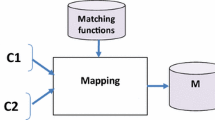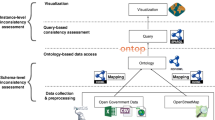Abstract
The rapid development of crowd-sourcing or volunteered geographic information both challenges and provides opportunities to authoritative geospatial information. Matching geospatial ontologies is an essential element to realizing the synergistic use of disparate geospatial information. We propose a new semi-automatic method to match formal and informal real life geospatial ontologies, at both terminology level and instance level, ensuring that overall information is logically coherent and consistent. Disparate geospatial ontologies are matched by finding a consistent and coherent set of mapping axioms with respect to them. Disjointness axioms are generated in order to facilitate detection of errors. In contrast to other existing methods, disjointness axioms are seen as assumptions, which can be retracted during the overall process. We produce candidates for retraction automatically, but the ultimate decision is taken by domain experts. Geometry matching, lexical matching and cardinality checking are combined when matching geospatial individuals (spatial features).
Access this chapter
Tax calculation will be finalised at checkout
Purchases are for personal use only
Similar content being viewed by others
Notes
- 1.
Definitions of concepts and roles.
- 2.
When B, C denote atomic concepts, B i = i: B, C j = j: C.
- 3.
In an algorithm, lines marked with * may require manual intervention.
- 4.
An ontology only with a TBox.
- 5.
Individuals from the Ordnance Survey of Great Britain (OSGB) Buildings and Places ontology and the OpenStreetMap ontology (See Sect. 4.2) are spatially linked by finding the smallest OSM polygon containing a point from OSGB address Layer 2. See Fig. 1 for examples. Polygons containing the same red point are linked.
A more sophisticated geometry matching method for generating spatial “sameAs” and “partOf” relations is under development and evaluation.
- 6.
We are aware that, an individual a in one ontology O i can be part of an individual b in another ontology O j, even if there are no other individuals in O i who can be part of b. This has be considered when designing our new geometry matching method.
- 7.
MIA refers to minimal incoherent assumption set when matching terminologies, and refers to minimal inconsistent assumption set when matching instances.
- 8.
CAS here refers to the calculation of consistent assumption set.
- 9.
The meanings of OSGB concepts are usually normal. OSGB: Parking ⊑ OSGB: Purpose.
- 10.
OSGB: Clothes refers to “garments worn over the body”. It is a secondary concept.
- 11.
A LogMap mapping may not.
- 12.
OSGB: Race Horse ⊑ OSGB: Animal. It is used to define OSGB: Racing Stables. .
- 13.
LogMap weakens some equivalence relations to inclusions, but also does not produce enough.
References
Baader F, Calvanese D, McGuinness DL, Nardi D, Patel-Schneider PF (eds) (2007) The description logic handbook. Cambridge University Press, Cambridge
Bouquet P (2007) Contexts and ontologies in schema matching. Context and ontology representation and reasoning. Roskilde University, Denmark
Bouquet P, Serafini L, Zanobini S (2003) Semantic coordination: a new approach and an application. International semantic web conference, pp 130–145
Buccella A, Cechich A, Fillottrani P (2009) Ontology-driven geographic information integration: a survey of current approaches. Comput Geosci 35:710–723
Domingos P, Lowd D, Kok S, Poon H, Richardson M, Singla P (2008) Just add weights: markov logic for the semantic web. Uncertainty reasoning for the semantic web I, ISWC International Workshops, URSW 2005–2007, Revised Selected and Invited Papers, 2008, pp 1–25
Du H, Anand S, Alechina N, Morley J, Hart G, Leibovici D, Jackson M, Ware M (2012) Geospatial information integration for authoritative and crowd sourced road vector data. Transactions in GIS, Blackwell Publishing Ltd, 2012, 16, 455–476
Euzenat J, Shvaiko P (2007) Ontology matching. Springer, Berlin
Geofabrik GmbH Karlsruhe: Geofabrik (2012) http://www.geofabrik.de
Giunchiglia F, Dutta B, Maltese V, Farazi F (2012) A facet-based methodology for the construction of a large-scale geospatial ontology. J Data Semant 1:57–73 Springer
Giunchiglia F, Shvaiko P, Yatskevich M (2004) S-Match: an algorithm and an implementation of semantic matching. European semantic web conference (ESWC), pp 61–75
Gruber TR (1993) A translation approach to portable ontology specifications. Knowl Acquisition 5:199–220
Gurobi Optimization Inc (2012) Gurobi optimizer reference manual. http://www.gurobi.com
Hart G, Dolbear C, Kovacs K, Guy A (2008) Ordnance survey ontologies. http://www.ordnancesurvey.co.uk/oswebsite/ontology
International Organization for Standardization (2011) ISO/DIS 19157: Geographic information—Data quality
Jackson MJ, Rahemtulla H, Morley J (2010) The synergistic use of authenticated and crowd-sourced data for emergency response. The 2nd international workshop on validation of geo-information products for crisis management (VALgEO). Ispra, Italy, pp 91–99, 11–13 Oct 2010. Available online: http://globesec.jrc.ec.europa.eu/workshops/valgeo-2010/proceedings
Jain P, Hitzler P, Sheth AP, Verma K, Yeh PZ (2010) Ontology alignment for linked open data. Int Semant Web Conf 1:402–417
Jean-Mary YR, Shironoshita EP, Kabuka MR (2010) ASMOV: results for OAEI 2010. The 5th international workshop on ontology matching (OM-2010)
Jiménez-Ruiz E, Grau BC (2011) LogMap: logic-based and scalable ontology matching. Int Semant Web Conf 1:273–288
Jiménez-Ruiz E, Grau BC, Horrocks I, Llavori RB (2009) Ontology integration using mappings: towards getting the right logical consequences. The 6th european semantic web conference (ESWC), pp 173–187
Meilicke C, Stuckenschmidt H (2009) An efficient method for computing alignment diagnoses. In: Third international conference on web reasoning and rule systems, pp 182–196
Meilicke C, Stuckenschmidt H, Tamilin A (2008a) Reasoning support for mapping revision. J Logic Comput 19:807–829
Meilicke C, Völker J, Stuckenschmidt H (2008b) Learning disjointness for debugging mappings between lightweight ontologies. Proceedings of the 16th international conference on knowledge engineering: practice and patterns, Springer, Berlin, pp 93–108
Niepert M, Meilicke C, Stuckenschmidt H (2010) A probabilistic-logical framework for ontology matching. American association for artificial intelligence for ontology matching. In: Proceedings of the 24th AAAI Conference on Artificial Intelligence, Atlanta, Georgia, AAAI Press
Nikolov A, Uren V, Motta E (2007) KnoFuss: a comprehensive architecture for knowledge fusion. The 4th international conference on knowledge capture, ACM, NY, pp 185–186
OpenStreetMap (2012) The Free Wiki World Map. http://www.openstreetmap.org
Ordnance Survey (2012) Ordnance Survey. http://www.ordnancesurvey.co.uk/oswebsite
Qi G, Ji Q, Haase P (2009) A conflict-based operator for mapping revision: theory and implementation. In: Proceedings of the 8th international semantic web conference. ISWC ‘09, Springer, Berlin, Heidelberg, pp 521–536
Reul Q, Pan JZ (2010) KOSIMap: use of description logic reasoning to align heterogeneous ontologies. The 23rd international workshop on description logics (DL 2010)
Sais F, Pernelle N, Rousset MC (2007) L2R: A logical method for reference reconciliation. In: AAAI conference on artificial intelligence. pp 329–334
Scharffe F, Liu Y, Zhou C (2009) RDF-AI: an architecture for RDF datasets matching, fusion and interlink. IJCAI 2009 workshop on Identity, Reference and Knowledge Representation (IR-KR)
Shvaiko P, Euzenat J (2012) Ontology matching: state of the art and future challenges. IEEE Transactions on Knowledge and Data Engineering
Sirin E, Parsia B, Grau BC, Kalyanpur A, Katz Y (2007) Pellet: a practical OWL-DL reasoner. Web semantics: science, services and agents on the World Wide Web, Elsevier Science Publishers B. V., vol 5, pp 51–53
Volz S, Walter V (2004) Linking different geospatial databases by explicit relations. International society for photogrammetry and remote sensing (ISPRS) congress, communication vol IV, pp 152–157
W3C (2009) OWL 2 Web Ontology Language. http://www.w3.org/TR/owl2-overview
Wang P, Xu B (2008) Debugging ontology mappings: a static approach. Comput Artif Intell 27(1):21–36
Wolger S, Siorpaes K, Bürger T, Simperl E, Thaler S, Hofer C (2011) A survey on data interlinking methods. Semantic Technology Institute (STI) Innsbruck, University of Innsbruck. Available online: http://www.insemtives.eu/publications/A_Survey_on_Data_Interlinking_Methods.pdf
Author information
Authors and Affiliations
Corresponding author
Editor information
Editors and Affiliations
Rights and permissions
Copyright information
© 2013 Springer International Publishing Switzerland
About this chapter
Cite this chapter
Du, H., Alechina, N., Jackson, M., Hart, G. (2013). Matching Formal and Informal Geospatial Ontologies. In: Vandenbroucke, D., Bucher, B., Crompvoets, J. (eds) Geographic Information Science at the Heart of Europe. Lecture Notes in Geoinformation and Cartography. Springer, Cham. https://doi.org/10.1007/978-3-319-00615-4_9
Download citation
DOI: https://doi.org/10.1007/978-3-319-00615-4_9
Published:
Publisher Name: Springer, Cham
Print ISBN: 978-3-319-00614-7
Online ISBN: 978-3-319-00615-4
eBook Packages: Earth and Environmental ScienceEarth and Environmental Science (R0)




